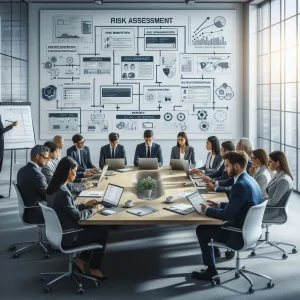In today’s rapidly evolving digital landscape, organizations face an unprecedented array of challenges, particularly in the realm of cybersecurity. Conducting a thorough tools audit can enhance these efforts by identifying the existing tools that best support security measures. Internal audits play a crucial role in ensuring that organizations not only comply with regulations but also effectively manage risks associated with their information systems. Defined as an independent, objective assurance and consulting activity designed to add value and improve an organization’s operations, internal audits are essential for evaluating the effectiveness of risk management, control, and governance processes. As businesses increasingly rely on technology, the relevance of internal audits has expanded to encompass a significant focus on cybersecurity.
Cybersecurity, in the context of internal auditing, refers to the measures and practices that protect an organization’s information systems from cyber threats. This intersection is becoming increasingly vital as cyber threats grow in frequency and sophistication. According to recent studies, organizations are experiencing a surge in cyber incidents, with attacks becoming more targeted and damaging. This reality underscores the necessity for robust cybersecurity measures, which are integral to the internal audit process.
The integration of cybersecurity tools into internal audits not only enhances the effectiveness of audits but also ensures that organizations are better equipped to identify vulnerabilities and respond to potential threats. As IT auditors and cybersecurity professionals navigate this complex landscape, understanding the importance of these tools becomes paramount. By leveraging advanced cybersecurity tools, internal auditors can provide deeper insights into the security posture of their organizations, ultimately fostering a culture of security awareness and resilience.
The Role of Internal Audits in Cybersecurity
In an era where cyber threats are increasingly sophisticated, the intersection of internal audits and cybersecurity has never been more critical. Internal audits serve as a vital mechanism for organizations to assess and enhance their cybersecurity posture. This section delves into the objectives of internal audits related to cybersecurity, their role in identifying vulnerabilities and compliance issues, and how IT auditors assess the effectiveness of cybersecurity measures.
Objectives of Internal Audits Related to Cybersecurity
The primary objective of internal audits in the context of cybersecurity is to ensure that an organization’s information systems are secure, reliable, and compliant with relevant regulations and standards. Internal audits aim to:
- Evaluate Risk Management: Internal auditors assess the effectiveness of an organization’s risk management strategies, ensuring that potential cybersecurity risks are identified and mitigated appropriately. This includes evaluating the adequacy of policies, procedures, and controls in place to protect sensitive data and systems from cyber threats[1].
- Ensure Compliance: Organizations must comply with various regulations and standards, such as GDPR, HIPAA, and PCI DSS. Internal audits help verify that cybersecurity practices align with these requirements, thereby reducing the risk of legal penalties and reputational damage[2].
- Enhance Operational Efficiency: By examining cybersecurity processes, internal audits can identify inefficiencies and recommend improvements. This not only strengthens security but also optimizes resource allocation within the organization[3].
Identifying Vulnerabilities and Compliance Issues
One of the critical functions of internal audits is to identify vulnerabilities within an organization’s cybersecurity framework. This process involves:
- Conducting Risk Assessments: Internal auditors perform comprehensive risk assessments to identify potential weaknesses in the organization’s cybersecurity posture. This includes evaluating the security of networks, applications, and data storage systems[4].
- Reviewing Security Controls: Auditors assess the effectiveness of existing security controls, such as firewalls, intrusion detection systems, and access controls. By testing these controls, auditors can determine whether they are functioning as intended and whether they adequately protect against known threats[5].
- Monitoring Compliance: Internal audits also focus on compliance with internal policies and external regulations. By reviewing documentation and conducting interviews, auditors can identify areas where the organization may be falling short in its cybersecurity practices, allowing for timely remediation.
Assessing the Effectiveness of Cybersecurity Measures
IT auditors play a crucial role in evaluating the effectiveness of an organization’s cybersecurity measures. Their responsibilities include:
- Testing Security Protocols: IT auditors conduct tests to evaluate the robustness of security protocols. This may involve penetration testing, vulnerability scanning, and social engineering assessments to simulate potential attacks and identify weaknesses[7].
- Analyzing Incident Response Plans: Auditors review the organization’s incident response plans to ensure they are comprehensive and effective. This includes assessing how well the organization can detect, respond to, and recover from cybersecurity incidents[8].
- Providing Recommendations: Based on their findings, IT auditors provide actionable recommendations to enhance cybersecurity measures. This may involve suggesting new technologies, improving training programs for employees, or revising policies to address identified gaps[9].
The role of internal audits in cybersecurity is indispensable for organizations aiming to fortify their defenses against cyber threats. By evaluating risk management practices, identifying vulnerabilities, ensuring compliance, and assessing the effectiveness of cybersecurity measures, internal auditors contribute significantly to enhancing an organization’s overall cybersecurity posture. As cyber threats continue to evolve, the collaboration between internal audit and cybersecurity professionals will be essential in safeguarding sensitive information and maintaining trust with stakeholders.
Essential Cybersecurity Tools for Internal Auditors
In the rapidly evolving landscape of cybersecurity, internal auditors play a crucial role in ensuring that organizations maintain robust security postures. The intersection of internal audit and cybersecurity is increasingly significant, as auditors must not only assess financial and operational risks but also evaluate the effectiveness of cybersecurity measures. To facilitate this, a variety of specialized tools are available that enhance the audit process, streamline risk assessments, and ensure compliance with regulatory standards. Below, we explore some essential cybersecurity tools that internal auditors should consider integrating into their audit practices.
1. Vulnerability Scanners
Description: Vulnerability scanners are automated tools designed to identify security weaknesses in systems, networks, and applications. They scan for known vulnerabilities, misconfigurations, and compliance issues.
Purpose in Audit: These tools assist internal auditors by providing a comprehensive overview of potential security risks within the organization’s IT infrastructure. By identifying vulnerabilities before they can be exploited, auditors can recommend timely remediation actions, thereby enhancing the organization’s overall security posture. Popular vulnerability scanners include Nessus, Qualys, and Rapid7, each offering unique features tailored to different environments and needs[1][2].
2. Security Information and Event Management (SIEM) Systems
Description: SIEM systems aggregate and analyze security data from across the organization’s IT environment in real-time. They collect logs and events from various sources, including servers, network devices, and applications.
Purpose in Audit: SIEM tools are invaluable for internal auditors as they provide insights into security incidents and anomalies. By analyzing patterns and correlating events, auditors can assess the effectiveness of the organization’s incident response capabilities and identify areas for improvement. Leading SIEM solutions, such as Splunk, IBM QRadar, and ArcSight, enable auditors to generate reports that support compliance and risk management efforts[3][4].
3. Governance, Risk, and Compliance (GRC) Platforms
Description: GRC platforms are integrated solutions that help organizations manage governance, risk, and compliance processes. They provide a centralized framework for policy management, risk assessment, and regulatory compliance.
Purpose in Audit: For internal auditors, GRC tools streamline the audit process by automating risk assessments and compliance checks. They facilitate the documentation of audit findings and recommendations, making it easier to track remediation efforts. Tools like RSA Archer, MetricStream, and ServiceNow GRC empower auditors to align audit activities with organizational objectives and regulatory requirements, ensuring a comprehensive approach to risk management[6].
4. Risk Assessment Tools
Description: Risk assessment tools are designed to identify, evaluate, and prioritize risks based on their potential impact and likelihood. These tools often include frameworks and methodologies for conducting risk assessments.
Purpose in Audit: Internal auditors utilize risk assessment tools to systematically evaluate the risks associated with various business processes and IT systems. By quantifying risks, auditors can provide management with actionable insights and recommendations for risk mitigation. Tools such as RiskWatch and RiskLens help auditors create risk profiles and develop strategies to address identified vulnerabilities effectively[7][8].
The integration of cybersecurity tools into internal audit processes is essential for enhancing the effectiveness of audits and ensuring that organizations are well-prepared to face evolving cyber threats. By leveraging vulnerability scanners, SIEM systems, GRC platforms, and risk assessment tools, internal auditors can provide valuable insights into the organization’s security posture, facilitate compliance, and support risk management initiatives. As the cybersecurity landscape continues to change, staying informed about these tools will empower IT auditors and cybersecurity professionals to safeguard their organizations more effectively.
Integrating Cybersecurity Tools into the Audit Process
In today’s digital landscape, the intersection of internal audit and cybersecurity has become increasingly critical. As organizations face a growing number of cyber threats, internal auditors must adapt their methodologies to incorporate cybersecurity tools effectively. This integration not only enhances the audit process but also strengthens the overall security posture of the organization. Below, we outline the steps for integrating cybersecurity tools into the existing audit framework, discuss best practices for leveraging these tools for data analysis and reporting, and emphasize the importance of collaboration between IT auditors and cybersecurity teams.
Steps for Integrating Cybersecurity Tools
- Assess Current Audit Framework: Begin by evaluating the existing internal audit framework to identify areas where cybersecurity tools can be integrated. This assessment should include a review of current processes, methodologies, and technologies used in audits[1].
- Identify Relevant Cybersecurity Tools: Research and select cybersecurity tools that align with the audit objectives. Tools may include vulnerability scanners, security information and event management (SIEM) systems, and data loss prevention (DLP) solutions. Each tool should be evaluated based on its ability to provide insights into the organization’s security posture and compliance requirements[2].
- Develop Integration Strategies: Create a plan for how these tools will be incorporated into the audit process. This may involve defining specific audit objectives that the tools will support, such as identifying vulnerabilities or assessing compliance with security policies. Ensure that the integration strategy aligns with the overall audit goals and organizational risk management framework[3].
- Train Audit Teams: Provide training for internal audit teams on how to use the selected cybersecurity tools effectively. This training should cover both technical aspects and the strategic application of the tools within the audit process. Empowering auditors with the right skills will enhance their ability to analyze data and draw meaningful conclusions[4].
- Implement and Monitor: Once the tools are integrated, implement them in the audit process and continuously monitor their effectiveness. Regularly review the outcomes of audits to ensure that the tools are providing valuable insights and that the audit process is evolving to meet new cybersecurity challenges[5].
Best Practices for Leveraging Cybersecurity Tools
- Data Analysis: Utilize cybersecurity tools to perform in-depth data analysis. For instance, SIEM systems can aggregate and analyze security data from various sources, helping auditors identify patterns and anomalies that may indicate security incidents. This data-driven approach enhances the accuracy and reliability of audit findings[6].
- Reporting: Develop clear and concise reporting mechanisms that leverage the insights gained from cybersecurity tools. Reports should not only highlight findings but also provide actionable recommendations for improving security practices. Visualizations and dashboards can be particularly effective in communicating complex data to stakeholders[7].
- Continuous Improvement: Establish a feedback loop where insights from audits inform the selection and use of cybersecurity tools. This iterative process allows organizations to adapt to emerging threats and continuously improve their audit methodologies[8].
Importance of Collaboration Between IT Auditors and Cybersecurity Teams
Collaboration between IT auditors and cybersecurity professionals is essential for a successful integration of cybersecurity tools into the audit process. By working together, these teams can:
- Share Knowledge: IT auditors bring a unique perspective on risk management and compliance, while cybersecurity teams possess deep technical expertise. This collaboration fosters a comprehensive understanding of the organization’s security landscape[9].
- Enhance Risk Assessment: Joint efforts in risk assessment can lead to more accurate identification of vulnerabilities and threats. By combining their insights, auditors and cybersecurity professionals can prioritize risks more effectively and allocate resources accordingly.
- Strengthen Security Posture: Ultimately, the collaboration between these teams contributes to a stronger security posture for the organization. By integrating cybersecurity tools into the audit process, organizations can proactively address vulnerabilities and enhance their overall resilience against cyber threats.
Integrating cybersecurity tools into the internal audit process is not just a best practice; it is a necessity in today’s threat landscape. By following the outlined steps, leveraging best practices, and fostering collaboration between IT auditors and cybersecurity teams, organizations can enhance their audit processes and strengthen their cybersecurity defenses. This proactive approach will not only protect sensitive data but also build trust with stakeholders and ensure compliance with regulatory requirements.
Challenges in Utilizing Cybersecurity Tools
In the realm of internal audits, the integration of cybersecurity tools has become increasingly vital as organizations face a growing array of cyber threats. However, the effective utilization of these tools is not without its challenges. This section will explore common obstacles faced by IT auditors and cybersecurity professionals when employing cybersecurity tools in internal audits, the impact of evolving cyber threats on audit strategies, and potential solutions to these challenges.
Common Challenges
1. Tool Compatibility
One of the primary challenges in utilizing cybersecurity tools during internal audits is tool compatibility. Organizations often employ a variety of cybersecurity solutions, each with its own set of functionalities and interfaces. This diversity can lead to difficulties in integrating these tools into a cohesive audit process. For instance, an internal audit team may find that the cybersecurity tools used for threat detection do not seamlessly communicate with those used for compliance monitoring, resulting in fragmented data and inefficiencies in the audit process[1].
2. Data Privacy Concerns
Another significant challenge is data privacy concerns. Internal auditors must navigate a complex landscape of regulations and organizational policies regarding data handling. The use of cybersecurity tools often involves accessing sensitive information, which raises questions about compliance with data protection laws such as GDPR or HIPAA. Auditors must ensure that their use of these tools does not inadvertently expose the organization to legal risks or breaches of confidentiality[2].
3. Skill Gaps
The rapid evolution of cybersecurity technologies has also led to skill gaps within internal audit teams. Many auditors may not possess the necessary technical expertise to effectively utilize advanced cybersecurity tools. This lack of proficiency can hinder the audit process, as auditors may struggle to interpret the data generated by these tools or fail to leverage their full capabilities. Continuous training and development are essential to bridge this gap, but organizations often face resource constraints that limit their ability to invest in such initiatives[3].
Impact of Evolving Cyber Threats
The landscape of cyber threats is constantly changing, with new vulnerabilities and attack vectors emerging regularly. This evolution significantly impacts audit strategies, as internal auditors must adapt their approaches to address these dynamic threats. For example, the rise of sophisticated ransomware attacks necessitates a shift in focus from traditional compliance audits to more proactive risk assessments that prioritize threat detection and response capabilities[4]. As cyber threats become more complex, internal auditors must remain vigilant and agile, continuously updating their audit methodologies to align with the latest cybersecurity trends.
Solutions for Overcoming Challenges
To effectively navigate the challenges associated with utilizing cybersecurity tools in internal audits, organizations can implement several strategies:
- Standardization of Tools: Organizations should strive to standardize their cybersecurity tools to enhance compatibility and streamline the audit process. By selecting a unified suite of tools that can integrate seamlessly, internal auditors can reduce fragmentation and improve data coherence[5].
- Robust Training Programs: Investing in comprehensive training programs for internal audit teams is crucial. Organizations should prioritize ongoing education in cybersecurity trends, tools, and best practices to ensure that auditors are equipped with the necessary skills to leverage these technologies effectively[6].
- Collaboration with Cybersecurity Teams: Fostering collaboration between internal audit and cybersecurity teams can enhance the effectiveness of audits. By working together, these teams can share insights, align their objectives, and develop a more holistic approach to risk management that addresses both compliance and security concerns[7].
- Regular Risk Assessments: Conducting regular risk assessments can help internal auditors stay ahead of evolving cyber threats. By identifying potential vulnerabilities and adjusting audit strategies accordingly, organizations can enhance their resilience against cyber attacks and ensure that their audit processes remain relevant and effective[8].
The intersection of internal audit and cybersecurity is increasingly critical in today’s digital landscape. While challenges such as tool compatibility, data privacy concerns, and skill gaps can hinder the effective use of cybersecurity tools in audits, organizations can implement strategic solutions to overcome these obstacles. By standardizing tools, investing in training, fostering collaboration, and conducting regular risk assessments, internal auditors can enhance their capabilities and better protect their organizations against the ever-evolving threat landscape.
Future Trends in Internal Audits and Cybersecurity Tools
As the digital landscape evolves, the intersection of internal audits and cybersecurity becomes increasingly critical. The rise of sophisticated cyber threats necessitates a proactive approach to auditing, where traditional methods are augmented by advanced technologies. This section explores the future trends shaping internal audits and the essential cybersecurity tools that will define the role of IT auditors in the coming years.
The Rise of AI and Machine Learning in Auditing
Artificial Intelligence (AI) and machine learning are set to revolutionize the internal audit landscape. These technologies enable auditors to analyze vast amounts of data quickly and accurately, identifying anomalies and potential risks that may go unnoticed through manual processes. AI algorithms can learn from historical data, improving their predictive capabilities over time, which is particularly beneficial in detecting fraudulent activities or compliance breaches[1][2].
Moreover, AI-driven tools can automate routine audit tasks, allowing auditors to focus on more strategic activities. This shift not only enhances efficiency but also improves the overall quality of audits by providing deeper insights into organizational risks and controls. As these technologies continue to mature, IT auditors will need to adapt their skill sets to leverage AI and machine learning effectively, ensuring they remain relevant in a technology-driven environment[3].
The Growing Importance of Continuous Auditing and Real-Time Monitoring
In an era where cyber threats can emerge and evolve rapidly, the traditional audit cycle is becoming obsolete. Continuous auditing and real-time monitoring are gaining traction as essential practices for internal auditors. These approaches allow organizations to assess their risk posture continuously, rather than relying on periodic audits that may miss critical vulnerabilities[4].
Continuous auditing leverages automated tools to evaluate controls and compliance on an ongoing basis, providing immediate feedback and enabling organizations to respond swiftly to emerging threats. Real-time monitoring tools can track user activities, system changes, and network traffic, alerting auditors to suspicious behavior as it occurs. This proactive stance not only enhances security but also fosters a culture of accountability within organizations, as employees are aware that their actions are being monitored[5].
The Evolving Role of IT Auditors in Cybersecurity
As the cybersecurity landscape becomes more complex, the role of IT auditors is evolving significantly. No longer confined to traditional auditing tasks, IT auditors are now expected to be strategic partners in their organizations’ cybersecurity efforts. This shift requires auditors to possess a deep understanding of cybersecurity principles, risk management, and the latest technological advancements[6].
In the future, IT auditors will likely take on a more advisory role, collaborating closely with cybersecurity teams to develop and implement robust security frameworks. They will be instrumental in assessing the effectiveness of security controls, identifying gaps, and recommending improvements. Additionally, as organizations increasingly adopt cloud services and remote work models, IT auditors will need to adapt their methodologies to address the unique challenges posed by these environments[7].
The future of internal audits is inextricably linked to advancements in cybersecurity tools and practices. As AI and machine learning reshape auditing processes, and as continuous auditing becomes the norm, IT auditors will find themselves at the forefront of organizational security efforts. Embracing these trends will not only enhance the effectiveness of internal audits but also ensure that organizations are better equipped to navigate the ever-evolving cybersecurity landscape. By staying informed and adaptable, IT auditors can play a pivotal role in safeguarding their organizations against emerging threats.
Conclusion
In today’s digital landscape, the intersection of internal audit and cybersecurity has never been more critical. As organizations increasingly rely on technology to drive their operations, the risks associated with cyber threats have escalated, making it imperative for internal auditors to integrate cybersecurity tools into their audit practices. This convergence not only enhances the effectiveness of audits but also fortifies the overall security posture of the organization.
The importance of cybersecurity tools in internal audits cannot be overstated. As we have explored, the integration of these tools allows internal auditors to identify vulnerabilities, assess risks, and ensure compliance with regulatory requirements more effectively. By leveraging advanced cybersecurity tools, auditors can gain deeper insights into the organization’s security landscape, enabling them to provide valuable recommendations that enhance risk management strategies.
Moreover, the dynamic nature of cyber threats necessitates that IT auditors and cybersecurity professionals remain vigilant and informed about the latest developments in both fields. Continuous education and adaptation to emerging technologies and threats are essential for maintaining an effective audit process. This proactive approach not only safeguards the organization’s assets but also builds trust with stakeholders by demonstrating a commitment to robust cybersecurity practices.
As a call to action, we encourage readers to assess their current audit practices critically. Evaluate the tools at your disposal and consider how they can be enhanced or updated to better address the evolving cybersecurity landscape. By doing so, you will not only improve the quality of your audits but also contribute to a more secure organizational environment. Embracing the synergy between internal audit and cybersecurity is not just a best practice; it is a necessity in today’s interconnected world.
Find out more about Shaun Stoltz https://www.shaunstoltz.com/about/
This post was written by an AI and reviewed/edited by a human.



